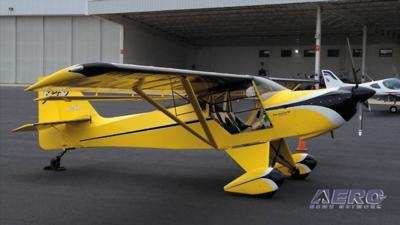Tue, Oct 08, 2013
NTSB Data Shows Overall GA Accident Rate Remained Flat
The number of experimental category aircraft fatal accidents fell by 25 percent in fiscal year 2013 according to FAA figures. Year-to-year fatal aviation accidents involving experimental aircraft totaled 55 during FY 2013, down from 73 in 2012. Lives lost this year totaled 70 people compared to 85 in 2012 - an 18 percent decrease.

The FAA sets "not to exceed" guidelines for fatal accidents every year as part of a 10-year accident reduction plan. The not-to-exceed goal for all experimentals in 2013 was 69 fatal accidents, so in 2013 the total was 14 accidents under that goal. Within that total, the number of fatal accidents for experimental amateur-built aircraft fell by 30 percent, from 50 in 2012 to 35 in 2013. Meanwhile, fatal experimental LSA accidents were down from 11 to eight.
"We are cautiously optimistic that these figures represent many of our safety initiatives starting to take hold in the E-AB community," said Sean Elliott, EAA vice president of advocacy and safety. "EAA has been working hard to promote transition and recurrent training, and we expanded the safety section of Sport Aviation to include monthly flight testing articles by EAA members with a strong flight test background.
"We hope that by encouraging builders and pilots who purchase E-AB aircraft to seek out the best training and information available, we can help those in our community avoid some of the most common accident causes."

While initial accident totals are available immediately at the end of the federal fiscal year, it takes the FAA up to two years to compile and analyze data that creates the accident rate - which is the number of fatal accidents in relation to hours flown. Interestingly, while the number of fatal accidents for experimental category aircraft plummeted, the number for the entire GA fleet was flat, according to the most recent NTSB data available.
"While we cannot yet calculate the most recent accident rate for E-AB and standard category aircraft, we think it is encouraging that the raw E-AB figures fell dramatically while as far as we know the rest of the GA segment stayed relatively flat," Elliott said. "This tells us that the E-AB drop is probably not merely attributable to a drastic reduction in total hours flown - otherwise the total GA figures would have dropped off also."
(Images from file representative of E-AB aircraft)
More News
Hold For Release Used by ATC to delay an aircraft for traffic management reasons; i.e., weather, traffic volume, etc. Hold for release instructions (including departure delay infor>[...]
Aero Linx: International Academy of Aviation and Space Medicine (IAASM) The Academy was founded in 1955, with the object of searching for and promoting new knowledge in Aviation an>[...]
“As FedEx begins its journey to restructure under the ‘One FedEx’ strategy, our pilots remind management that there’s still unfinished business to address i>[...]
Also: NATA CEO In Legal Dilemma, WestJet Encore Settle, Drone Bill H.R. 8416, USN Jet Trainer GAMA released their 1Q/24 GA Aircraft Shipment and Billing Report -- with mostly mixed>[...]
Mach Technique [ICAO] Describes a control technique used by air traffic control whereby turbojet aircraft operating successively along suitable routes are cleared to maintain appro>[...]
 ANN's Daily Aero-Term (06.01.24): Hold For Release
ANN's Daily Aero-Term (06.01.24): Hold For Release ANN's Daily Aero-Linx (06.01.24)
ANN's Daily Aero-Linx (06.01.24) Aero-News: Quote of the Day (06.01.24)
Aero-News: Quote of the Day (06.01.24) Airborne 05.31.24: 1Q GA Sales, 200th ALTO LSA, Spitfire Grounding
Airborne 05.31.24: 1Q GA Sales, 200th ALTO LSA, Spitfire Grounding ANN's Daily Aero-Term (06.02.24): Mach Technique [ICAO]
ANN's Daily Aero-Term (06.02.24): Mach Technique [ICAO]




